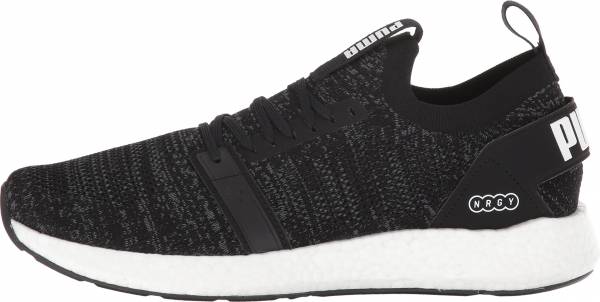Facts
Rankings
Expert Reviews
Experts are training geeks, who post reviews at youtube, directly at RunRepeat or at their own websites. Each expert is categorized from level 1 to level 5 based on expertise. See stats on expert reviews and how we calculate scores here.
Are you an expert? Apply to contribute here.
90 / 100 based on 1 expert reviews
-
The Puma NRGY Neko Engineer knit is an affordable lifestyle shoe which has the materials, features, and the comfort of a much more expensive product.
- The Puma NRGY Neko Engineer Knit came as part of the brand’s NRGY Neko series. It is a workout shoe, created for various training activities, including cardio, HIIT, and studio classes. The style of the trainer also allows it to be worn for daily walking.
- Like its sibling, the NRGY Neko Knit, the shoe features a knit upper material. However, the fabric of the Neko Engineer Knit is crafted to be softer and more close-fitting. It also uses a ribbing on the collar for a more sock-like feel.
- The synthetic overlay at the back is thick and sturdy to support the rearfoot. However, it is only attached at the sides to eliminate excess pressure on the heel.
- As the name suggests, the footwear utilizes the NRGY midsole. It is made of lightweight and springy TPU (thermoplastic polyurethane) balls that are fused together to provide responsive cushioning.
The Puma NRGY Neko Engineer Knit can be obtained in both men’s and women’s variations. The men’s sizes range from US 7 to 14, while the ladies’ shoes come between US 5.5 and 11. The width is available in standard profiles: D - Medium for men and B - Medium for women. The soft knit upper is meant to fit snug but not constricting.
This Puma workout shoe employs a full-length rubber compound to guard the bottom of the platform. It is textured and lugged to ensure grip on gym surfaces. The rubber also protrudes up at the front, creating a protective toe bumper.
The outsole has two cut-outs: a triangular one in the heel and a narrow, wavy one in the forefoot. They make the unit more pliable in these areas and reduce the weight of the shoe.
Puma’s proprietary NRGY compound makes up the midsole of the NRGY Neko Engineer Knit. It consists of tiny TPU balls which quickly restore their original form after being squeezed. These balls are fused together to create a unit that absorbs shock upon impact but easily bouces back, ready for the next move. The NRGY midsole is also created to be lightweight and flexible to accommodate the agile nature of workout sessions.
The Puma NRGY Neko Engineer Knit is aptly named after the knit fabric which makes up its upper unit. The tightly-woven areas are interchanged by looser stitches on the toe box and the sides. Such design delivers a combination of support and freedom where they are most needed. The material is also made soft and breathable to create a second-skin feel.
The shoe has a slip-on design and features a sock-like ribbing on the collar. It easily stretches when the footwear is put on or taken off and remains taut once the foot is inside. The pull tabs at the back and the front assist in the on-and-off action.
A thick synthetic overlay with the Puma logo is added at the heel of the trainer. It is only attached at the sides, staying loose in the middle section. That way it doesn’t burden the rearfoot but provides the necessary support when it’s needed.
A lace-up closure secures the fit on the instep. It runs through the apertures in the woven material and can be adjusted at the wearer’s preference. Two thin synthetic overlays are placed on both sides of the forefoot, forming the first pair of eyelets for added support.














